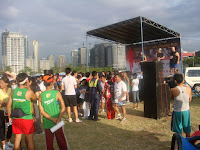

With the advent of April, we shall again experience a series of long holidays.
April 4,5,6,9,10,11, and 12, seven (7) golden days of no office work and time for relaxation and vacation with the family.
For runners this will also be an excellent opportunity to take active run/walk on the beach, mountain areas, trails, remote villages, resorts or just even within the city limits should there be no out of town plan in the pipeline. The common denominator wherever we might be is the
“Heat of Summer is ON” and comes along the
“High Humidity” associated with it which we shall be experiencing during these forthcoming days.
With the expected temperature rise, an early morning run at 5-7am will be from 27-30 degrees C, an early evening run at 6-8pm will be from 30-32 degrees C and a late evening run at 8-10pm will be from 28-30 degrees C. A mid-day temperature of 33-35 degrees C should not even be considered unless you have an ultramarathon event entered which definitely you will have an unvoidable daytime run. My best wishes to the participants of the
Bataan 102 Ultramarathon scheduled on April 5,2009.
Livestrong.com has given four (4) ways for runners to stay cool.
1.
Dress For Success – No cottons. Use synthetic fabrics of latest technology to help pull sweat away from skin surface, thus cooling the body.
2.
Time Your Runs Wisely – depending on where you are, you may have to alter your training schedule significantly to ensure that you are not training in the heat. You may be better of waking up early before the sun rises up or running late at night . Another option is to plan your route along shaded paths (like UP Diliman) or set a route where you could leave bottled water at regularly spaced interval (like Ultra Oval).
3.
Drink Often – staying cool means to take plenty of fluid with you. Often runners underestimate the heat and find themselves feeling dehydrated midway into their runs. Bring a hydration bottle or a hydration backpack, while it may add extra weight it is a small price to pay for suffering heat related illness during workout.
4.
Cross Train – when heat is too much for you to take and risk of engaging in the heat far outweighs the benefit of a 5-10K run, then “cross training” is an excellent option to get a great workout and beat the heat. Swimming is an excellent way to give your legs a break from impact of running and beat the heat. Cross train on a sport and/or activity that you will also find enjoyment.
Jeff Galloway on an article for
Active.com gave the following tips for running workouts during summer heat;
1. Run before the sun gets above the horizon.
2. If you must run when the sun is up, pick a shady course.
3. Run during the evening and night.
4. Have an indoor facility available.
5. Don’t wear a hat! You lose most of your body heat through the top of your head. Covering the head will cause a quicker internal build-up of heat.
6. Wear light clothing, but not cotton.
7. Pour water over your head.
8. Do your short runs in instalments.
9. Take a pool break or a shower chill-down.
10. Sun screen- a mixed review.
11. Drink six to eight ounces of a sport drink
Symptoms of Heat Diseases:-
- Intense heat build-up in the head
- General overheating of the body
- Significant headache
- Significant nausea
- General Confusion and loss of concentration
- Loss of muscle control
- Excessive sweating and then cessation of sweating
- Clammy skin
- Excessive rapid breathing
- Muscle cramps
- Feeling faint
- Unusual heart beat or rhythm
Who are with the Risk Factors; - If you have viral or bacterial infection
- If you suffer from dehydration (especially due to alcohol)
- If you are overweight
- If you have severe sunburn
- If you lack of heat training
- If you exercise more than what you are used to
- If you experienced heat disease in the past
- If you if experienced two or more nights of extreme sleep deprivation
- If you have certain medical conditions including high cholesterol, high blood pressure, extreme stress, asthma, diabetes, epilepsy, cardiovascular disease, smoking or general lack of fitness.
We want to enjoy our summer and continue with our running/walk training and knowing the preventive measures far outweigh the medical methods and consequences we will be faced should we fall victim to our own unsafe running practices.
Stay Cool and Run Cool this summer.
















































